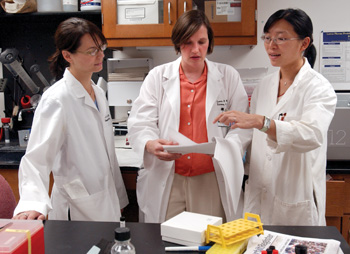
From left, Julie Bastarache, M.D., Lorraine Ware, M.D., and Ling Wang, M.D., go over data in the lab.
photo by Dana Johnson
Education efforts focus on bench-to-bedside path
As Vanderbilt University Medical Center works to highlight the pressing need for scientists interested in drug discovery and development, pharmaceutical companies are doing the same.
In his recent talk “Opportunities in the Pharmaceutical Industry in the 21st Century,” Robert R. Ruffolo Jr., Ph.D., president of research and development at Wyeth Pharmaceuticals, gave graduate students a glimpse into the investigative side of the pharmaceutical business and reminded those interested in a career in the industry that it was not easy. The talk was hosted by graduate students in the Department of Pharmacology.
“We are not an industry that is well understood,” Ruffolo admitted. “We are looking for hard-core scientists. We are the most regulated industry in the world. While drugs are safer than they have ever been before, the expectations for safety are unattainable and newer drugs are taking longer to develop.
“Working in the industry is the most technical, complex, costly and risky job. It takes up to 20 years to make one drug. The average is 16 years. It is more difficult to put a drug on the market than to put a person on the moon,” Ruffolo said.
So why would a graduate student want to enter the pharmaceutical industry?
“There is no greater thrill than discovering drugs and helping people,” said Ruffolo, who created the drug carvedilol (Coreg/Kredex) for the treatment of congestive heart failure. “I created a drug that reduced the death rate by 65 percent. That's why I work in the industry.”
Despite the recent trend of training programs nationwide to steer graduates into the molecular biology and genetic arena, Vanderbilt has stayed the course with support from the National Institutes of Health that highlighted the need for investigators interested in drug design and development.
“The NIH has expressed concern over the loss of such programs,” said Joey Barnett, associate professor of Pharmacology, Medicine, Microbiology and Immunology. “It too recognized the need for students to know how to turn discoveries made in the labs into new treatments for patients.”
In July Barnett brought together directors of graduate training programs to discuss the need for more bench-to-bedside training programs, the challenges of developing training programs suited for both graduate and undergraduate curriculums as well as the opportunities that were available once students were ready to branch out.
The meeting, with more than 70 attendees from the United States and Canada, focused on ideas on how to reverse the trend and meet the ever-changing needs of scientific and medical communities.
“The goal of graduate Pharmacology programs is to train investigators who will be leaders in academia, the pharmaceutical industry as well as regulatory agencies,” Barnett said.
Ruffolo agrees, and said that “more is better” in the areas of: communication and leadership skills, scientific breadth and depth, course work and scientific training.
“The pharmaceutical industry is not for everyone. It is a hard place to work. The costs and risks are extreme and the stakes are high,” he said. “Communication is key, breadth and depth in training is critical. I can not emphasize this enough — publish, publish, publish, publish.
“Science is our foundation and innovation is key,” Ruffolo said. “We get to combine basic and applied research.”
Barnett said speakers like Ruffolo, who spent a major portion of his entire career in the pharmaceutical industry, help him and other program directors develop curriculum and training priorities.













